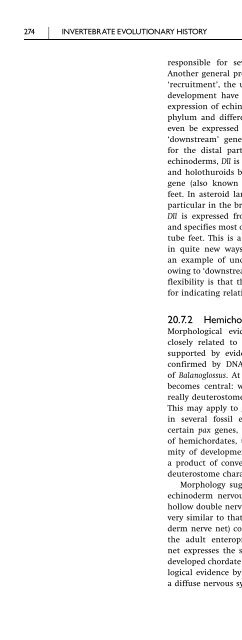An Introduction to the Invertebrates, Second Edition - tiera.ru
An Introduction to the Invertebrates, Second Edition - tiera.ru
An Introduction to the Invertebrates, Second Edition - tiera.ru
Create successful ePaper yourself
Turn your PDF publications into a flip-book with our unique Google optimized e-Paper software.
274 INVERTEBRATE EVOLUTIONARY HISTORYresponsible for several of <strong>the</strong> unique features of <strong>the</strong> phylum.<strong>An</strong>o<strong>the</strong>r general property of genes demonstrated by echinoderms is‘rec<strong>ru</strong>itment’, <strong>the</strong> use of old genes for new roles. Genes regulatingdevelopment have been shown <strong>to</strong> be extraordinarily flexible; <strong>the</strong>expression of echinoderm genes downstream may be unique <strong>to</strong> <strong>the</strong>phylum and different in <strong>the</strong> different classes, and <strong>the</strong> genes mayeven be expressed at different regula<strong>to</strong>ry levels. For example, <strong>the</strong>‘downstream’ gene distal-less (Dll ) is well known <strong>to</strong> be necessaryfor <strong>the</strong> distal part of <strong>the</strong> limb <strong>to</strong> develop in Drosophila: amongechinoderms, Dll is expressed in <strong>the</strong> tube feet of asteroids, echinoidsand holothuroids but not in those of ophiuroids, where a differentgene (also known from Drosophila) controls development of tubefeet. In asteroid larvae, Dll is expressed in ec<strong>to</strong>dermal cells and inparticular in <strong>the</strong> brachiolar arms, used for attachment. In echinoidsDll is expressed from <strong>the</strong> first appearance of <strong>the</strong> adult <strong>ru</strong>dimentand specifies most of <strong>the</strong> st<strong>ru</strong>ctures on <strong>the</strong> oral side, spines as well astube feet. This is a clear example of rec<strong>ru</strong>itment of genes <strong>to</strong> servein quite new ways, differing in different echinoderms. It is alsoan example of unchanging Hox genes acting on different targetsowing <strong>to</strong> ‘downstream’ changes. A more practical consequence of thisflexibility is that <strong>the</strong>se downstream genes may be quite unreliablefor indicating relationships.20.7.2 HemichordatesMorphological evidence suggests that hemichordates are moreclosely related <strong>to</strong> echinoderms than <strong>to</strong> chordates, an idea earlysupported by evidence from 18S rDNA genes and more recentlyconfirmed by DNA data from <strong>the</strong> whole mi<strong>to</strong>chondrial genomeof Balanoglossus. At once <strong>the</strong> question foreshadowed in Chapter 18becomes central: which of <strong>the</strong> apparent ‘chordate characters’ arereally deuteros<strong>to</strong>me characters that have been lost in echinoderms?This may apply <strong>to</strong> gill slits, as is suggested by <strong>the</strong> finding of <strong>the</strong>min several fossil echinoderms and supported by evidence fromcertain pax genes, which are expressed similarly in <strong>the</strong> pharyngesof hemichordates, urochordates and cephalochordates. This uniformityof development suggests that hemichordate gill slits are nota product of convergence but are <strong>the</strong> continuation of a primitivedeuteros<strong>to</strong>me character.Morphology suggests homology between <strong>the</strong> hemichordate andechinoderm nervous systems, with little relation <strong>to</strong> <strong>the</strong> chordatehollow double nerve cord. The <strong>to</strong>rnaria larva has a diffuse nerve netvery similar <strong>to</strong> that of echinoderm larvae which (unlike <strong>the</strong> echinodermnerve net) continues in<strong>to</strong> <strong>the</strong> adult with little change. Yet in<strong>the</strong> adult enteropneust Saccoglossus kowalevski this diffuse nervenet expresses <strong>the</strong> same genes, in <strong>the</strong> same order, as in <strong>the</strong> highlydeveloped chordate central nervous system. This extends <strong>the</strong> morphologicalevidence by suggesting that <strong>the</strong> deuteros<strong>to</strong>me ances<strong>to</strong>r hada diffuse nervous system, later centralised in <strong>the</strong> chordate lineage.











